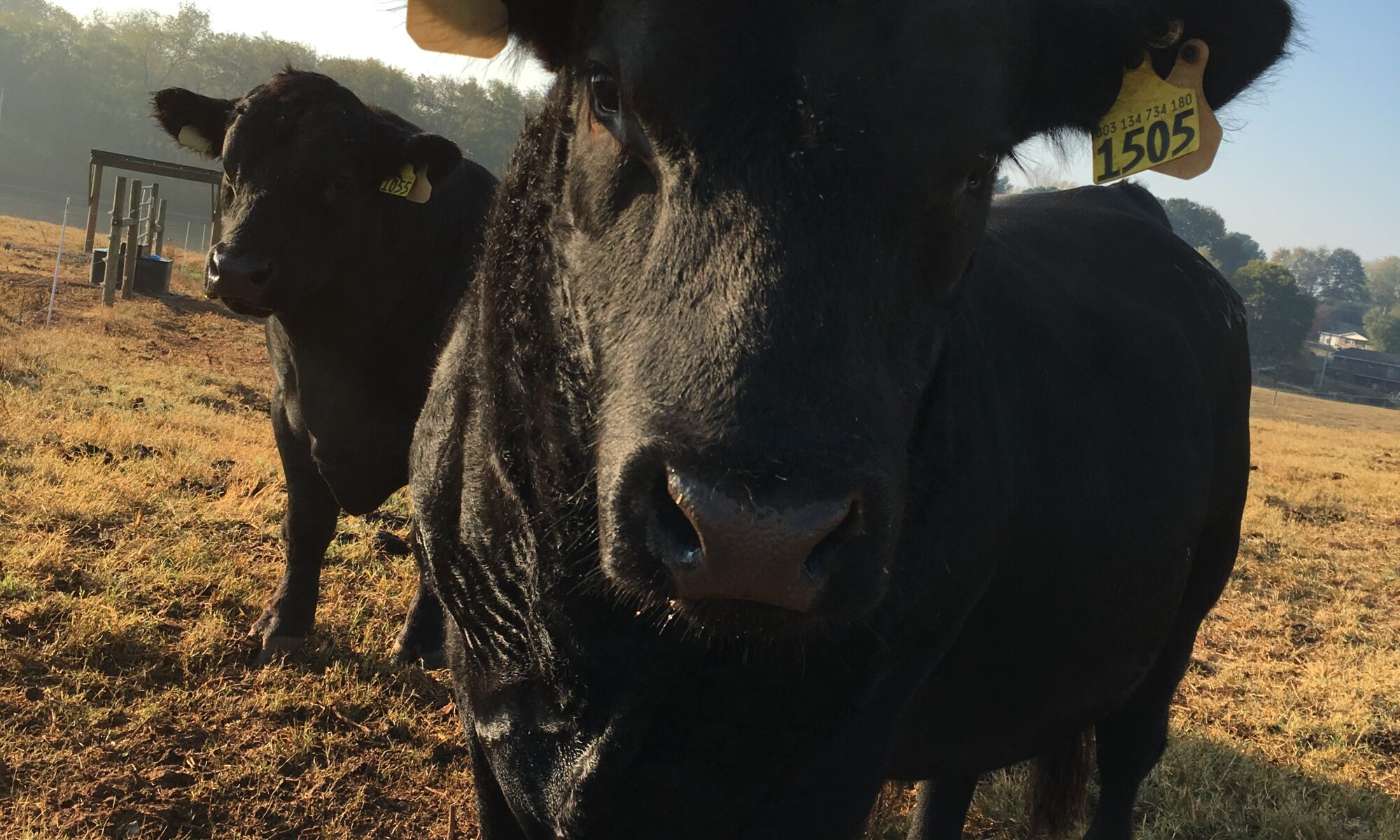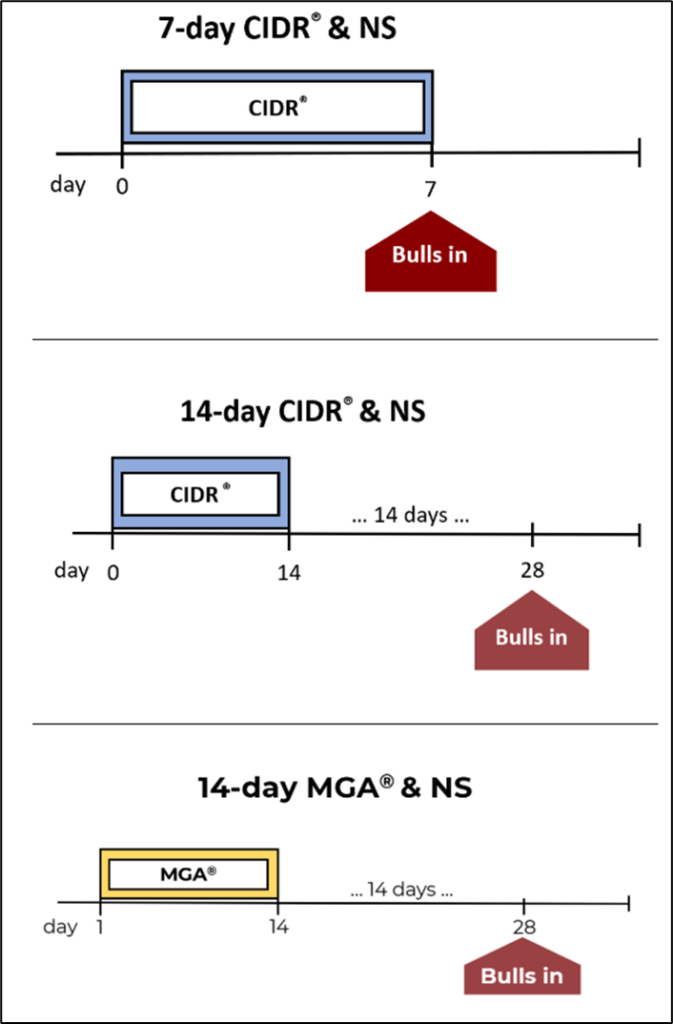

Dr. Saulo Zoca
Assistant Professor and Beef Cattle Reproduction Specialist
Department of Animal Science
P: 931-486-2129
Co-Authors: Samantha Roberts, Graduate Student; and, Dr. Sarah Moorey, Assistant Professor
Increasing the number of females pregnant early in the breeding season (first 21 days) has great economic impact. Reproductive technologies have the ability to assist beef producers to accomplish this goal. Estrus synchronization with artificial insemination (AI) is becoming more popular with producers; however, it may not be the best option for some beef producers where facilities or labor are not appropriate for AI. Nevertheless, there are options to use estrus synchronization with natural service.
A time commitment is part of using an estrus synchronization protocol and there is an increase in labor requirement compared to only natural service, but there are many benefits to using this technology for the purpose of natural service. The most defined benefit in the literature is the increase in the number of females pregnant early in the breeding season, in consequence an increase in calves born earlier (within the first 21 days) in the subsequent calving season. This means the producer will have a more uniform calf crop, that will be older and heavier at weaning which in turn reflects in greater revenue. Further, calving early in the calving season allows for the cows to have a greater post-partum interval, allowing a greater time to recover from calving and facilitating them to breed back sooner in the following breeding season. Also, using a synchronization protocol for the purpose of setting up cows for natural service can be a way to ease into the process of AI without the extra cost.
In this article we will discuss some management considerations for the success of a natural service breeding using estrus synchronization as well as two options of estrus synchronization.
Cow and Heifer Management
A critical requirement for cows and heifers to be able to efficiently sustain a pregnancy is their body weight and condition. When considering breeding heifers, they should weigh 55-65% of their predicted mature body weight, be at a body condition score of approximately 6 (from a 1 to 9 scale where 1 is emaciated and 9 is obese) and have reached puberty. A recommendation is to have a veterinarian perform a pelvic exam and assess the reproductive maturity of heifers to ensure that they can sustain and deliver a pregnancy. We recommend a pelvic area greater than 150 cm2 and greater than 50% of heifers in a group with a reproductive tract score of 4 or 5 (1 to 5 scale where 1 is infantile reproductive score and 5 is a fully mature reproductive tract) approximately 4 weeks prior to breeding. For more information about heifer development, we recommend reading UT extension publication W1089 (https://utia.tennessee.edu/publications/wp-content/uploads/sites/269/2023/10/W1089.pdf).
When setting cows up for breeding, a producer should consider how long it has been since their cows have calved. It is recommended that cows rest from a minimum of 30 days post calving. This allotted time allows cows to recover from parturition, so uterine involution can occur properly, and they can regain cyclicity. However, a longer period can improve results. Thus, 45-90 days post calving is the recommended interval to use before breeding cows again. Another advantage of using a synchronization protocol, is that it can “jump start” those cows that have not returned cyclicity after they have surpassed the suggested time frame after calving, also pre-pubertal heifers may start cycling after a synchronization protocol. Return to cyclicity in post-partum cows or induction of puberty in pre-pubertal heifers is dependent on use of progestins.
Bull Management
Bulls should undergo a breeding soundness exam (BSE) 30 to 60 days before each breeding season which consists of a physical exam, including rectal palpation where internal reproductive organs are evaluated, scrotal circumference that meets the minimal requirements, and semen quality. Minimum requirements to pass a BSE includes 70% normal sperm morphology and 30% progressive motile sperm.
A producer should also consider the bull-to-cow ratio. Several studies have demonstrated similar results in pregnancy rates with varying bull-to-cow ratio from 1:15 to 1:60 in non-synchronized beef females. However, when estrus synchronization is used, more females will become receptive (in heat) in a short period of time, thus the recommended ratio is 1 bull to 25 cows with preference to mature and experienced bulls instead of young and virgin bulls. The proposed age for a bull that will be used on a synchronized herd is 2+ years old. This ratio will vary whether more simple or more complex synchronization protocols are adopted. More simple protocols usually yield lower synchronization; thus, a greater bull-to-cow ratio (1-to-25 or 30) can be used where a more complex protocol that yields a greater synchrony will require a lower bull-to-cow ratio (1-to-15). The producer should also check regularly if the bull is injured or if his libido is low at any point during the breeding season since this can affect the herd pregnancy rates.
Estrus Synchronization Protocols for the use of Natural Service
There are numerous types of synchronization protocols. The best fit depends on the needs of the producer. A simple and straightforward protocol is the 1 Shot PG and NS (Figure 1), this is where a shot of Prostaglandin (PG) is given, and the bull is turned in with females. This is the only time that the cows and heifers must be ran through the chute, but this protocol only works if the cows and heifers are already cycling.
Figure 1. Estrous synchronization using one administration of prostaglandin (PG) and then the bull is turned in “1 Shot PG & NS” (image from beefrepro.org).

Other protocols that have been used successfully with natural service involve the use of progestins, whether through a controlled internal drug release device (CIDR) or through feeding MGA (heifers only). CIDR is an intravaginal progesterone-releasing insert and MGA (heifers only) is a feed additive that have been proven to induce puberty in heifers and promote cyclicity in cows after calving. Thus, protocols like those in Figure 2 are another option. In the 7-day CIDR and NSprotocol, a CIDR inserted on day 0 and it is removed 7 days later with bull turned in with the cows the day of CIDR removal. This protocol requires the cows or heifers to be worked twice, to insert and remove the CIDR. Similarly to 7-day CIDR and NSprotocol the 14-day CIDR and NS protocol requires females to be worked through the chute twice. In the14-day CIDR and NS protocol females receive a CIDR on day 0 and 14 days later it is removed, then the cows or heifers are turned in with the bull 14 days later. The 14-day MGA and NS protocol (Figure 2) can only be used for heifers due to product label. The heifers are fed MGA that is mixed in their feed, and after 14 days MGA is removed from the feed mix. Similarly to the 14-day CIDR and NS protocol, after 14 days from the last MGA feeding, the bull is turned in with the heifers. This protocol does not require the heifers to be put through a chute. An important thing to know is that there will be heat activity right after the removal of the CIDR or the MGA, but this estrus (heat) cycle is not fertile and will not result in a successful pregnancy, this happens because an old follicle is ovulated, and old follicles have low fertility. Therefore, the bull should be turned in after 14 days of last feeding of MGA or CIDR removal in these protocols, so we can avoid overuse of bulls in non-fertile cycles.
Figure 2. Estrous synchronization protocols using progestins (CIDR or MGA) for beef cows and heifers. MGA is labeled for heifer use only (image from beefrepro.org).

Conclusion
There are several options of synchronization protocols that producers can use to help improve their reproductive management and number of females pregnant early in the breeding season, including for natural service. This has the potential to improve herd management, calf uniformity, and revenue. If you have any questions regarding cow and heifer management, BSEs, or the different types of estrus synchronization protocols please consult with your veterinarian, local county extension agent, or your extension beef cattle specialist.